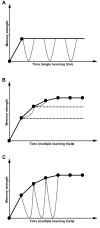Reconsolidation: maintaining memory relevance
- PMID: 19640595
- PMCID: PMC3650827
- DOI: 10.1016/j.tins.2009.05.002
Reconsolidation: maintaining memory relevance
Abstract
The retrieval of a memory places it into a plastic state, the result of which is that the memory can be disrupted or even enhanced by experimental treatment. This phenomenon has been conceptualised within a framework of memories being reactivated and then reconsolidated in repeated rounds of cellular processing. The reconsolidation phase has been seized upon as crucial for the understanding of memory stability and, more recently, as a potential therapeutic target in the treatment of disorders such as post-traumatic stress and drug addiction. However, little is known about the reactivation process, or what might be the adaptive function of retrieval-induced plasticity. Reconsolidation has long been proposed to mediate memory updating, but only recently has this hypothesis been supported experimentally. Here, the adaptive function of memory reconsolidation is explored in more detail, with a strong emphasis on its role in updating memories to maintain their relevance.
Figures

References
-
- Bartlett FC. Remembering: A study in experimental and social psychology. MacMillan; 1932.
-
- Schacter DL, et al. The cognitive neuroscience of constructive memory. Annu Rev Psychol. 1998;49:289–318. - PubMed
-
- McGaugh JL. Time-dependent processes in memory storage. Science. 1966;153:1351–1358. - PubMed
-
- Nader K, et al. Fear memories require protein synthesis in the amygdala for reconsolidation after retrieval. Nature. 2000;406:722–726. - PubMed
-
- Tronson NC, Taylor JR. Molecular mechanisms of memory reconsolidation. Nat Rev Neurosci. 2007;8:262–275. - PubMed
MeSH terms
Grants and funding
LinkOut - more resources
Full Text Sources
Medical

